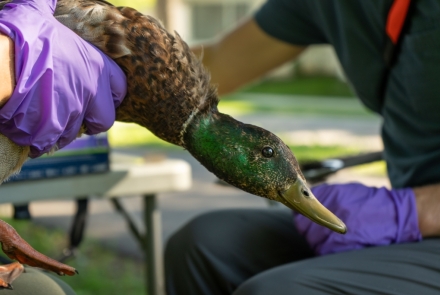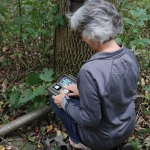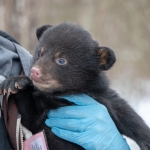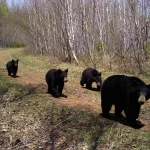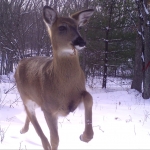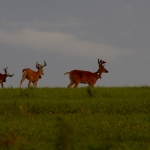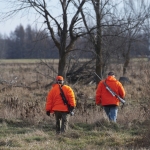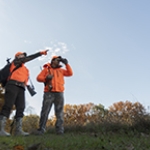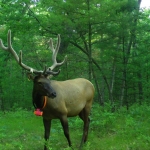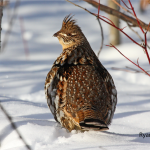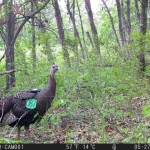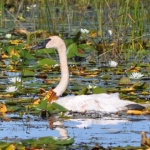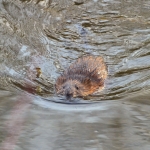Wildlife research
Wildlife research staff specialize in a variety of fields, including wildlife population dynamics, monitoring, harvest projection and disease ecology, with expertise spanning the diversity of wildlife across the state.
Staff collaborates with universities, federal and state agencies, tribal partners and conservation groups across the state and country to help meet the DNR’s high-priority research needs. The wildlife research team also provides science participation opportunities through hunter, trapper, landowner and public volunteer programs.
Wildlife Research Studies
Snapshot Wisconsin
Goal: Provide the opportunity for the public to get involved in wildlife monitoring and provide data necessary for wildlife management decisions. Learn more about contributing to wildlife research with the Snapshot Wisconsin community.
Black Bear Litter And Diet Survey
Goal: Determine key reproductive parameters, such as litter size and frequency, in each bear management zone. Help the project by reporting occupied bear dens in fall and winter.
Evaluating The Black Bear Abatement Program
Goal: Evaluate the cost-effectiveness of various abatement measures for reducing agricultural damage by black bears.
Southwest Wisconsin CWD, Deer and Predator Study
Goal: Evaluate population-level impacts of various deer mortality factors, focusing on CWD impacts, and improve our understanding of deer/predator associations. Details are available on the project website.
Advancing The Deer Population Model
Goal: Use available deer data to assess the current deer population monitoring framework and explore new models for improvement.
Pneumonia In White-Tailed Deer
Goal: Identify the causative disease agent(s) responsible for fatal pneumonia in wild white-tailed deer in Wisconsin, any potential link to chronic wasting disease and the potential importance to the deer population.
Deer Hunter Demographics and Deer Harvest
Goal: Describe changing patterns in the number of deer hunters, project future hunter numbers and examine the consequences of fewer deer hunters in terms of deer harvest.
Hunter Perceptions and Responses to Chronic Wasting Disease
Goal: Understand Wisconsin deer hunter perceptions of CWD and how hunter behaviors might affect the spread of CWD.
Assessing Elk Population Monitoring
Goal: Evaluate and improve elk population monitoring data collection and analyses to better inform the Elk Advisory Committee’s decision-making process.
Sensitivity and Viability of Sharp-tailed Grouse in Northwest Wisconsin
Goal: Uncover potential demographic drivers that influence population growth and identify the minimum viable population that can be sustainable.
Susceptibility of Ruffed Grouse to Changing Winter
Goal: Investigate the susceptibility of ruffed grouse to projected changes in winter variability.
Detectability and Movement of Wild Turkeys in Wisconsin
Goal: Estimate accurate turkey recruitment metrics by pairing multiple monitoring methods, including GPS/radio-tracked turkeys and data collected from trail cameras.
Assessing Impacts of Goose and Swan Herbivory on Wild Rice
Goal: To better understand the impacts of herbivory (grazing) of wild rice by Canada geese and trumpeter swans.
Beaver Influences on Trout Populations
Goal: Characterize the impacts of beavers, beaver dam construction and beaver dam removal on cold water streams and trout populations in eco-regions and beaver management zones.
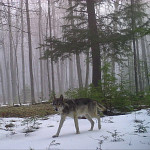
Evaluation and Improvement of Wolf Population Monitoring
Goal: To review, evaluate and improve monitoring of Wisconsin's wolf population to inform management decisions.
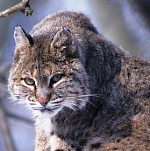
Understanding the Dynamics of Wisconsin's Bobcat Hunters and Trappers
Goal: Determine the primary drivers of bobcat hunter and trapper numbers and project future permit wait times under various harvest scenarios.
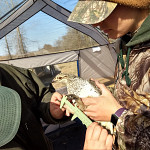
Evaluation of Sharp-Tailed Grouse Survey Methods for Improved Population Monitoring
Goal: To evaluate the effectiveness of current sharp-tailed grouse lek count survey protocols and explore potential alternative procedures.
Scientific Consulting
In addition to the research projects above, the Office of Applied Science also provides consultation services to the Division of Fish, Wildlife and Parks. These consultation services are often in the form of population analyses, scientific design and analysis services and consultation on management issues to ensure the best possible scientific information is available to decision-makers.
The open dialogue between the Office of Applied Science and the Bureaus of Wildlife Management and Fisheries Management helps drive our research focuses so that research directly fills the research needs of decision-makers.
Publications and reports
View a list and links to our recent journal publications and reports. Visit the Deer and CWD Scientific Publications page for papers on that topic.

